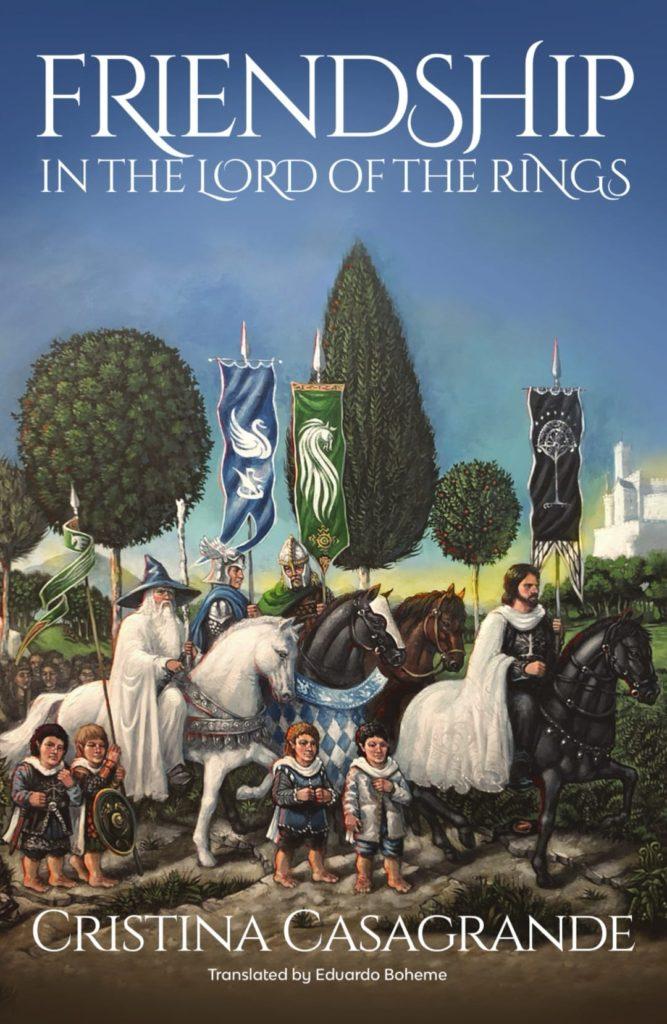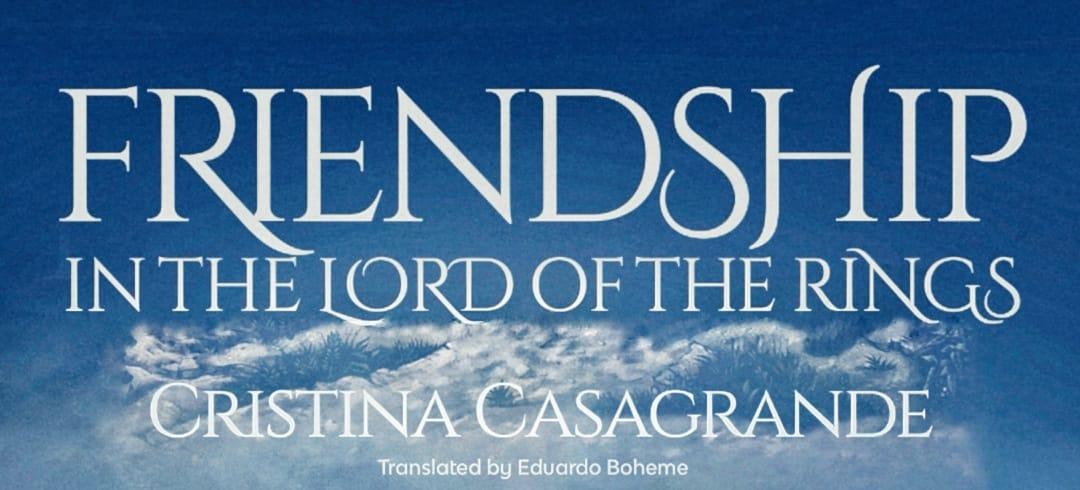by Cecilia Drudi, Sara Massino and Sebastiano Tassinari
Today, March 15, Luna Press Publishing, the publishing company founded by Francesca Barbini in Edinburgh and boasting numerous Tolkien-themed publications, is publishing the book Friendship in The Lord of the Rings by Cristina Casagrande. Cristina works for HarperCollins Brasil on several projects related to Tolkien and is doing a PhD at the University of São Paulo in Brazil, where she is exploring the link between Tolkien and philosophy. On the occasion of the publication of his book, Casagrande granted us this interview with some anticipations about the work. We thank Francesca Barbini for having put us in direct contact with the author.

Welcome Cristina, thank you for agreeing to answer our questions.
Thank you so much! I’m honoured to answer this interview.
What was the inspiration that led you to write Friendship in The Lord of the Rings? Can you tell us a particular anecdote?
At first, I intended to study friendship, and I thought it would be a good idea to study the book The Lord of the Rings, which I admired very much, as the object of my investigation. But I didn’t know this was possible, especially in Brazil. So, I cogitate to study a Brazilian series of children books called Sítio do Picapau Amarelo [“The Yellow Woodpecker Farm“], by Monteiro Lobato. But I wasn’t satisfied with the idea. One day, my husband bought a DVD box of the extended editions movies, by Peter Jackson, and we both watched together, just to have fun. And I got so excited to watch the extended movies (before of it, I only had watched the versions for movie theatres) that it made me to take courage and ask my master’s advisor if I could study the book The Lord of the Rings, being “friendship” as the main theme of the research. Fortunately, she accepted, and then we thought it would be a good idea to make a comparison with the movies as well.
Did writing about the value of friendship in The Lord of the Rings help you deepen the idea you previously had about friendship or confirm it?
I think the theological part of the study helped me to understand it more. The philosophical one, having Aristotle in the The Nicomachean Ethics as a guide, made to confirm it. Even so, it was so exciting to know that a man, years before Christ understood so many things that are so current that it seemed to me that he wrote yesterday, not thousands of years ago! He made me to understand more clearly that I must have a good character if I want to have a good friend. And self-knowledge shows us that we are not so good as we thought we were… But the theological part, having Thomas Aquinas in The Summa Theologica as a guide, made me think how it is possible to be a friend of someone even the other part doesn’t give the virtue of benevolence back, that is, even it’s not reciprocal. Having God as a friend, the human friendships are more possible.
In The Lord of the Rings the theological part is not so evident, but it’s possible to see it, especially when you study the Divine Providence, and the works of mercy (spiritual and corporal ones).
What difficulties, if there were any, did you face in writing and then publishing Friendship in The Lord of the Rings? How long did it take you to write it?
It was my master degree in Brazil. After I finished it, I looked for publishers in Brazil which were interested in launch it. Then, I had to change the way of writing, edit the chapters, take off, or add some texts. From the contract to the launching, it took two years. About six months after launching it in Portuguese, I asked to my friend Eduardo Boheme if he could translate it into English, and so he did. About one year later, I found Luna Press as good publisher for my book. It’s not an easy task, but it’s certainly worthwhile.
Are there any differences between the original Brazilian version and the new English edition? Have you updated anything in the text?
I don’t think it has a significally difference. But I had to adapt it to the britain standards.
What is the overall structure of the work?
The two first chapters contextualize the theorical part, so we can understand more what friendship in the classical conception is. We can know more about cinema language as well, because besides of studying the book, I study the movies (a little bit). The other chapters show the lack of friendship, by the corruption, having Gollum as a (sad) model of it, and then it shows the kinds of friendship, political and private ones, considering the members of the Fellowship of the Ring. At last, the book approaches eucatastrophe, mercy, and Divine Providence as pillars of the victory against Sauron — and the importance of friendship to articulate those things.
Why, in writing your book Friendship in The Lord of the Rings, did you consider philosophical texts such as Aristotle’s Nicomachean Ethics and the Summa Theologica of St. Thomas Aquinas? What led you to consider these two authors along with Tolkien?
I studied these topics at the College, in an elective subject about Aristotle, and years before in groups of study (superficially). So, for me, it was clear that there was this background in Tolkien’s cosmovision, even if he didn’t write in an allegorical way, nor even if he didn’t notice that at the beginning. But he indeed wrote in his letters that he noticed that The Lord of The Rings is catholic, while he was revisioning it. And the philosophy and theology of the Catholicism is based on thinkers like Aristotle and Aquinas. There are many studies in the world that can see these inspirations in Tolkien’s works, like the book The Flame Imperishable, by Jonathan S. Mcintosh. As we can see in the last Tolkien’s book, edited by Hostetter, The Nature of Middle-earth, these authors are truly present in Tolkien’s mind, even if it is unconsciously, because Tolkien never wished to proselytize his work.
Considering where the landscape of Tolkien studies stands today, where would you place your book? Do you think about it as an accessible reading mainly for scholars and fans of the Professor’s texts, or also for those who only know Tolkien’s work through Peter Jackson’s film trilogy?
I think it’s a very versatile book. It can be read by the ones who only know the movies (but I hope they finish reading it willing to read Tolkien’s work), and it may be very interesting, and even instructive to the advanced Tolkien’s readers, including the scholars.
In The Fellowship of the Ring Tolkien tells about characters from different parts of Middle-earth who meet in Rivendell. Here, they form a company to pursue a common purpose that transcends their diversity. Can “wanting the same things and not wanting the same things” be considered a principle on which to base friendship?
I think so! I think this is a great question because nowadays we talk so much about diversity in Tolkien’s and other authors’ writings and for me the Fellowship is an obvious example that how much Tolkien believed in how diversity of peoples could be joined in the same ideal (and that is one of the topics of the book). This is beautiful and it seems he anticipated many issues that would be discussed years later. At the same time he does in a way it is universal, it means, the different people can be considered many kinds of diversity throughout the time and space. For Tolkien, friends are equals in virtue, and they have the same ideals. They can be diverse in culture or in physical aspect, and that’s fine! What really join them is the values, that makes them be equals.
In The Lord of the Rings, Tolkien deals several times with the topic of separation, forced or necessary, of friends. How, according to the author, does friendship change in the harsh ordeal of separation?
In a human perspective, it’s necessary to have communication to “feed” the friendship. When people separate (by any circumstance) for a long time and don’t have any kind of communication, the friendship between them can cool down. But in the case of Tolkien stories, they can be even stronger because their fighting for the same ideals and their hearts are together, even they cannot see each other for a while.
By writing your book, you have made a precious contribution to the passionate study of scholars of the Professor’s work. Do you think that people who reach the various and heterogeneous Tolkienian realities scattered all over the world can feel united even if separated in a friendship similar to the one of the Fellowship?
It’s really a beautiful way of seeing Tolkienian community. I think we are united for the same ideal, not only studying, but being delighted by Tolkien stories, and having so much fun. We are united by the same “ideal” and that’s definitely a characteristic of friendship.
In recent times internationally renowned scholars, highly attended events and even newspapers have proposed interpretations of the bonds between Tolkien’s male characters as characterized by homoerotic or homoamorous aspects. Is this aspect also explored in your book, or do you think it is a key of interpretation that is beyond Tolkien’s intentions?
I didn’t go that way in my book. C.S. Lewis wrote a book, The Four Loves (that I mention in my book), in which he writes separately about affection, eros, friendship and charity. Friendship, for him, is a kind of love more spiritual than corporal (he uses the term “natural”). So necessarily the approach of friendship dispenses the kind of love called “eros”, that involves sexuality. Of course, we can have more than one kind of love in relation to the same person. I consider my husband my best friend, for instance, and my love for him has a great part of charity (which is a kind of love that we have for God, and He has for us), but the typical spousal love would be eros, which necessarily has the sexual union. In the case of the hobbits and the other characters of the Fellowship and the other friends among the free people, I really don’t see any sexual tension. If I see something different from friendship between Frodo and Sam, for example is charity, the love that Sam has to Frodo is almost devotional. Quoting Lewis: «Otherwise we are arguing like a man who should say ‘If there were an invisible cat in that chair, the chair would look empty; but the chair does look empty; therefore there is an invisible cat in it’». I’m convinced that Tolkien wanted to write a story about friendship, not a eros love story, because there are many of them in the history of literature — Tolkien himself wrote some good ones like Beren and Lúthien. And that is so true that he overshadowed the love story between Aragorn and Arwen in The Lord of The Rings, because it is a “hobbito-centric” story, I would say a “friend-centric” story, no one better than the Hobbits to express the friendship love.
Do you plan to write and publish another book in the near future?
Absolutely, I’d like to publish my thesis. I’d like to keep on writing theorical books and start to write fictional ones as well.

You can order Friendship in The Lord of the Rings here
Author: Cristina Casagrande
Publisher: Luna Press Publishing
Paperback: 216 pages
Dimensions: 13.97 x 21.59 cm
Here on YouTube you can watch the official book launch!


